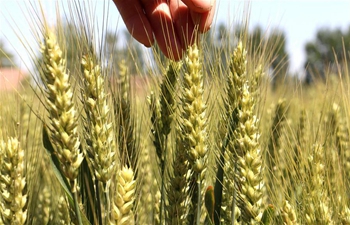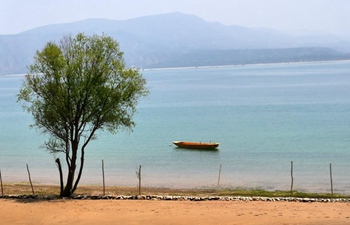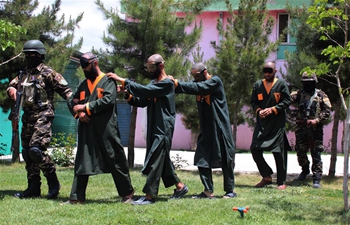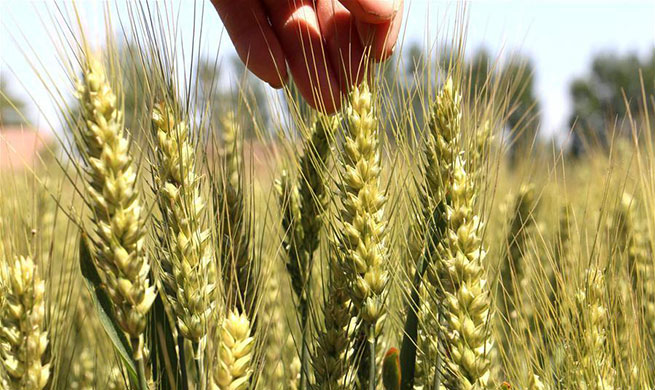VALCAMONICA, Italy, May 21 (Xinhua) -- With millions of cubic meters of timber still on the ground, and summer approaching, authorities and environmentalists in northern Italy were engaged in a race against time.
Over six months have past since a storm called "Vaia" hit four northern regions with unusually warm winds exceeding 150 km per hour and strong rainfalls.
It was Oct. 29, and the event resulted in an unprecedented damage to forests in northeast Trentino, Friuli, and Veneto, and northwest Lombardy regions, which provide two thirds of all Italian timber.
No single event of extreme weather had ever caused such extensive destruction to Italian forests, and the reaction it triggered appeared, in its own way, unprecedented as well.
PUBLIC, PRIVATE JOIN FORCES
In the aftermath of the disaster, the Italian branch of the Programme for the Endorsement of Forest Certification (PEFC) -- a non-profit organization for the sustainable management of global forests -- launched a "fair supply chain" to try to mitigate the environmental and socio-economic impact.
Sirocco winds knocked down some 20 million trees -- over 8.5 million cubic meters of wood -- equal to the amount of wood harvested in 5 to 7 years of average silviculture, according to the Italian Ministry of Agriculture.
The affected areas stretched over 42,500 hectares of woods overall, and the regional governments estimated damages for 50 million euros (55.8 million U.S. dollars) in Lombardy, 93 million in Veneto, 250-300 million in Trentino, and 615 million in Friuli Venezia Giulia.
With the fair supply chain project, the PEFC urged public forestry consortia and mountain communities, and private firms to take action by collecting and purchasing as much timber as possible from the damaged forests at fair prices.
For all those willing to join the project, the timber would be made traceable through the specific logo "Filiera Solidale" (Fair Supply Chain) guaranteed by PEFC-Italy.
Up to mid-May, at least 17 private firms, 12 civil society organizations, and 20 public entities joined the project, yet promoters kept pushing ahead.
"Over six months after Vaia, we still have almost 5 million cubic meters of wood to collect," PEFC-Italy secretary general Antonio Brunori told Xinhua.
"We have to move fast, because knocked-down timber will start being attacked by insects in the summer months, with a further risk that diseases may further spread to healthy trees," he explained.
Adding to the risk of parasites and fungus, timber lying on the ground would anyway become useless for the industry within two years, according to the forest sciences researcher.
The campaign also aimed at developing a stronger national supply chain by boosting local resources, which made sense since Italy was one of the world's largest furniture manufactures, but imported 80 percent of timber, according to industrial furniture association Federlegno-Arredo.
A third goal was to further boost the certification of sustainably managed forests, which today amounted to 9.8 percent of Italy's 10.9 million hectares of forests, according to the 2018 PEFC report.
Overall, environmentalists hoped this approach would boost Italian forests' resilience to climate change.
CHALLENGING TASK
In the woods of Lombardy's Valcamonica -- a valley in central Alps hosting prehistoric rock drawings listed by UNESCO as World Heritage Site -- local consortium's workers had a challenging task.
It was their job to clean the forest from all trees knocked down by Vaia storm, trunk after trunk.
Using a funicular-like rope, they cautiously reached each tree stock, secured it, and lifted it down to the nearest road, where timbers would be piled up, and remains processed by wood waste grinders.
In this valley alone, the storm ravaged over 1,000 ha of forest, knocking down some 300,000 cubic meters of wood, according to the local Mountain Community.
Local authorities received a first tranche of 1.96 million euros out of total 7 million emergency funds so far allocated by the Lombardy region.
"Up to now, we have spent 30 percent of regional funds, with cleaning and collection activities ongoing in 18 work sites, and we have reclaimed some 50,000 ha of woods," Gian Battista Sangalli, Valcamonica Mountain Community's forest service manager, told Xinhua.
Their deadline was set in July, the official added, not least for the thousands of tourists expected in summer, who would make collection activities more difficult and risky.
Much would remain to be done, however, since the official explained the first 1.96 million funds covered "20 percent of the overall costs of cleaning out the 1,000 ha of damaged woods."
ADDED VALUE
Among the 17 private firms that first answered the PEFC's fair supply-chain call was Marlegno, a family-owned company in Bergamo province operating in the sustainable building field and specializing in prefabricated wooden premises.
"Being part of the fair supply chain is not going to provide an immediate economic return, yet it will strengthen our positioning on the market," chief executive officer Angelo Luigi Marchetti told Xinhua.
The company posted a turnover of 13 million euros in 2018, and would benefit from the development of a larger, sustainable use of local timber.
"We focused on sustainable production, and every element helping clients understand our profile and see that we are coherent with our mission is a strong added value for us," the CEO explained.
CHINESE BUYERS
Finally, in the aftermath of the Vaia storm, a surprising request for timber came also from China, an event that operators and experts described as exceptional.
"Foreign buyers of Italian timber usually come from Austria, Slovenia, and sometimes Germany... it had never happened before to have Chinese buyers on the Italian market," Brunori said.
"We had a confirmation during the first public timber auctions after the storm, and especially in Trentino and Veneto regions."
The expert explained the first action prices were at 12-14 euros per cubic meter -- from an average 50-60 euros in normal times in those areas -- but soon clients bid for more than double.
When the PEFC-Italy asked the reasons, intermediaries said they had Chinese customers ready to spend those figures, because they had transport means already available for shipping.
Brunori said this novelty was quite welcome.
"After an initial surprise, it proved positive, because the Chinese buyers' interest helped support market prices, thus avoiding excessive downward speculation," he stressed.
"Besides, it has also showed domestic operators the timber from storm-affected areas is still valuable and, if they will not move timely, it will take other path, including the road to China."













